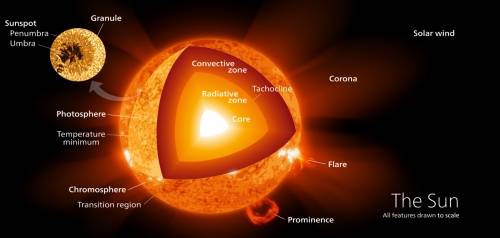 Close Topic Options
Close Topic OptionsSun Research
Sun Research - Sciences, Education, Art, Writing, UFO - Posted: 19th Nov, 2019 - 2:59pm
Sun Research
Origins of Sun's swirling spicules discovered. For the first time, a computer simulation -- so detailed it took a full year to run -- shows how spicules form, helping scientists understand how spicules can break free of the sun's surface and surge upward so quickly. Source 8c
Distance to Earth: 92.96 million mi
Surface temperature: 5,778 K
Escape velocity (From the surface): 617.7 km/s; 55 × Earth
Equatorial surface gravity: 274.0 m/s2; 27.94 g; 27,542.29 cgs; 28 × Earth
Mean radiance (Isol): 2.009×107 W·m−2·sr−1
Luminosity (Lsol): 3.828×1026 W; ≈ 3.75×1028 lm; ≈ 98 lm/W efficacy Wikipedia

Sun Research (Hover)
Sun Research UFO & Writing Art Education Sciences
The more we can learn about the universe the better off and more advanced we will become. Knowing more about the sun and how it operates the more we can learn about what places will have a stable sun to colonize the planets around it. All in all this helps us further our goals of reaching for the stars.
Research Sun
Yes, the sun is an ordinary, solar-type star after all. The Sun is a solar-type star, a new study claims -- resolving an ongoing controversy about whether the star at the center of our Solar System exhibits the same cyclic behavior as other nearby, solar-type stars. Source 5r.
Research Sun
Sun's core rotates four times faster than its surface. The sun's core rotates nearly four times faster than the sun's surface, an international team of astronomers reports. The most likely explanation is that this core rotation is left over from the period when the sun formed, some 4.6 billion years ago. Source 6o.
Sun Research
I think the core of the sun is the primary fuel of the sun. The fact it is spinning four times faster than the outer surface could be the source of its gravitational pull sort of like the earths own gravitational pull. Thus the reason it attracted orbiting bodies that formed over time. The more we know about this star the better we will be able to know about potential planets to habitat as we reach the stars.
Sun Research Sciences Education Art Writing & UFO
Central mysteries of solar physics. Scientists have shed new light on one of the central mysteries of solar physics: how energy from the Sun is transferred to the star's upper atmosphere, heating it to 1 million degrees Fahrenheit and higher in some regions, temperatures that are vastly hotter than the Sun's surface. Source 3f.
 TOPIC: Sun Research
TOPIC: Sun Research